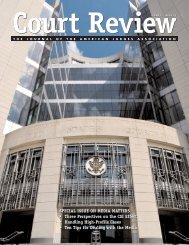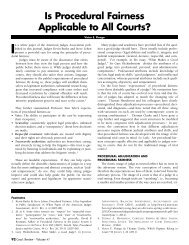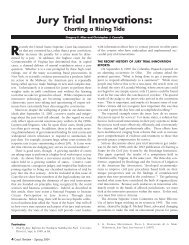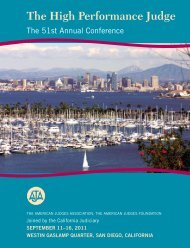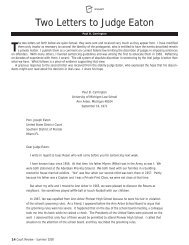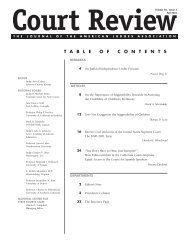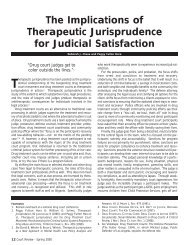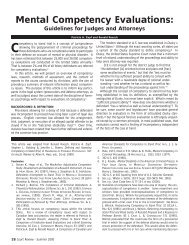Special Issue on Procedural Fairness - American Judges Association
Special Issue on Procedural Fairness - American Judges Association
Special Issue on Procedural Fairness - American Judges Association
- No tags were found...
Create successful ePaper yourself
Turn your PDF publications into a flip-book with our unique Google optimized e-Paper software.
Court ReviewT H E J O U R N A L O F T H E A M E R I C A N J U D G E S A S S O C I A T I O NVolume 44, <str<strong>on</strong>g>Issue</str<strong>on</strong>g> 1/2 2007–2008EDITOR’S NOTEThis special issue of Court Review focuses <strong>on</strong> procedural justice. TomTyler has called procedural justice the most powerful explanatory c<strong>on</strong>ceptfor why people obey rules that restrict their behavior in ways theywould otherwise find unacceptable. David Rottman has written “having asense that court decisi<strong>on</strong>s are made through processes that are fair is thestr<strong>on</strong>gest predictor by far of whether members of the public approve of orhave c<strong>on</strong>fidence” in courts. <strong>Procedural</strong> justice is worthy of a deep look, andthis issue of Court Review does precisely that – it presents papers from someof the nati<strong>on</strong>’s leading scholars who have been thinking about proceduraljustice and related c<strong>on</strong>structs.The special issue begins with <strong>Judges</strong> Burke and Leben’s White Paper <strong>on</strong>procedural justice. Theirs is the first White Paper issued by the <strong>American</strong><strong>Judges</strong> Associati<strong>on</strong> (and the Burke/LebenWhite Paper was recently endorsed by theC<strong>on</strong>ference of State Court Administrators attheir 2008 Annual Meeting, July 30, 2008).Originally presented at the meeting of the<strong>American</strong> <strong>Judges</strong> Associati<strong>on</strong> in September2007 and available <strong>on</strong> the AJA website, it isthe first article in this special issue. It summarizesboth arguments and empiricalresearch making in detail the case for statecourts that Tyler and Rottman make, that is,procedural justice matters. It matters a lot, intheir opini<strong>on</strong>. It is the key c<strong>on</strong>struct for courtimprovement.The rest of the issue examines procedural justice in a variety of c<strong>on</strong>texts.The issue c<strong>on</strong>tains an article by Tyler and an essay by Rottman. Tyler andRottman join <strong>Judges</strong> Burk and Leben in arguing for the centrality of proceduraljustice in the justice system. Weisz, Wingrove, and Faith-Slaker jointhem in extolling procedural justice c<strong>on</strong>cepts; they see procedural justice asimportant for improving the experiences for children in the courts, thoughthey point out research documentati<strong>on</strong> is still sparse. Support for proceduraljustice c<strong>on</strong>tinues with Dent<strong>on</strong>, who explains how the California courts haveembraced the procedural justice c<strong>on</strong>cept to drive major reforms. Abuwala andFarole also applaud procedural justice in their study of its impact in a limitedjurisdicti<strong>on</strong> court c<strong>on</strong>text (landlord-tenant, housing courts) in New York City.In a summary of a large body of research, Sivasubramaniam and Heuerpoint out that procedural justice has different meanings for decisi<strong>on</strong> recipients(i.e., litigants) than for decisi<strong>on</strong> makers (i.e., judges), and am<strong>on</strong>g otherthings they indicate how these differences might cause reform problems in thejustice system. Bornstein and Dietrich summarize a complementary literature– distributive justice studies – and counsel that courts pay attenti<strong>on</strong> to outcomesas well as procedures. Finally, Wexler points to another complementaryarea – therapeutic jurisprudence – and argues desirable outcomes are evenmore likely to occur by heeding the less<strong>on</strong>s of the therapeutic jurisprudenceframework. – Alan TomkinsCourt Review, the quarterly journal of the <strong>American</strong><strong>Judges</strong> Associati<strong>on</strong>, invites the submissi<strong>on</strong> of unsolicited,original articles, essays, and book reviews. Court Reviewseeks to provide practical, useful informati<strong>on</strong> to the workingjudges of the United States and Canada. In each issue,we hope to provide informati<strong>on</strong> that will be of use tojudges in their everyday work, whether in highlightingnew procedures or methods of trial, court, or case management,providing substantive informati<strong>on</strong> regarding anarea of law likely to be encountered by many judges, or byproviding background informati<strong>on</strong> (such as psychology orother social science research) that can be used by judgesin their work. Guidelines for the submissi<strong>on</strong> of manuscriptsfor Court Review are set forth <strong>on</strong> page 55. CourtReview reserves the right to edit, c<strong>on</strong>dense, or reject materialsubmitted for publicati<strong>on</strong>.Court Review is in full text <strong>on</strong> LEXIS and is indexed in theCurrent Law Index, the Legal Resource Index, andLegalTrac.Letters to the Editor, intended for publicati<strong>on</strong>, are welcome.Please send such letters to <strong>on</strong>e of Court Review’seditors: Judge Steve Leben, 301 S.W. 10th Ave., Suite278, Topeka, Kansas 66612, email address:sleben@ix.netcom.com; or Professor Alan Tomkins, 215Centennial Mall South, Suite 401, PO Box 880228,Lincoln, Nebraska 68588-0228, email address: atomkins@nebraska.edu.Comments and suggesti<strong>on</strong>s for thepublicati<strong>on</strong>, not intended for publicati<strong>on</strong>, also are welcome.Advertising: Court Review accepts advertising for productsand services of interest to judges. For informati<strong>on</strong>,c<strong>on</strong>tact Deloris Gager at (757) 259-1864.Photo credit: Mary Watkins (maryswatkinsphoto@earthlink.net). The cover photo shows the Knox CountyCourthouse in Rockland, Maine. The courthouse, c<strong>on</strong>structedin 1874, is listed <strong>on</strong> the Nati<strong>on</strong>al Register ofHistoric Places.©2008, <strong>American</strong> <strong>Judges</strong> Associati<strong>on</strong>, printed in theUnited States. Court Review is published quarterly by the<strong>American</strong> <strong>Judges</strong> Associati<strong>on</strong> (AJA). AJA membersreceive a subscripti<strong>on</strong> to Court Review. N<strong>on</strong>-member subscripti<strong>on</strong>sare available for $35 per volume (four issuesper volume). Subscripti<strong>on</strong>s are terminable at the end ofany volume up<strong>on</strong> notice given to the publisher. Prices aresubject to change without notice. Sec<strong>on</strong>d-class postagepaid at Williamsburg, Virginia, and additi<strong>on</strong>al mailingoffices. Address all corresp<strong>on</strong>dence about subscripti<strong>on</strong>s,undeliverable copies, and change of address toAssociati<strong>on</strong> Services, Nati<strong>on</strong>al Center for State Courts,Williamsburg, Virginia 23185-4147. Points of view oropini<strong>on</strong>s expressed in Court Review are those of theauthors and do not necessarily represent the positi<strong>on</strong>s ofthe Nati<strong>on</strong>al Center for State Courts or the <strong>American</strong><strong>Judges</strong> Associati<strong>on</strong>. ISSN: 0011-0647.Cite as: 44 CT. REV. ___ (2007-2008).2 Court Review - Volume 44



